
SHIRAZ

Provincial Capital of Fars. Altitude 1,600 meters, 500 km S of
Esfahan (935 km from Tehran) on a good road. 300 km N-E of Bushehr on a good
road in course of completion. 600 km E of Abadan on road in process of being
restored. International airport and link-up with Iran Air Internal airline.
An eight-kilometer-long motorway links the airport to the
outskirts of the town, eight uninterrupted kilometers of rose-garden, aptly
announcing Shiraz, the "City of roses and poets".
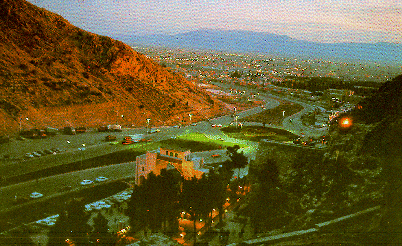
"Darvazeh
Ghoran (Entrance to
Shiraz)"
Parks with magnificent trees are one of the town's
attractions. Long wide shady avenues lead from one side to the city other. They
are an incitement to leisurely wanderings during siesta time. Exemplary modern
achievements, including remarkable hotels and very striking university buildings
are conducive to a pleasant stay. Because of the city's altitude (1,600 meters)
the climate is extremely pleasant. It is very mild in winter and not too hot in
summer. Nearby Persepolis and the international fame of its annual art festival
have confirmed Shiraz as a tourist center. The Bagh-e Eram, in Shiraz,
famous for its gardens, is a typical late Qajar palace, now donated to Shiraz
University.
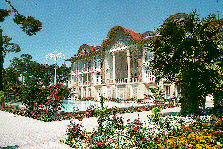
"Bagh-e Eram"
Shiraz, Naranjistan,
19th century. This very beautiful house and garden which originally belonged to
the Ghavam family now been restored to become the home of the Asia Institute. A
fine painted title frieze borders the roof, while the facade has a dado of
carved stone slabs. The high central porch fronts a room lined with mirror
mosaic, and the garden has been restored to an original design.
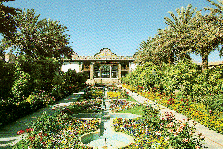
"Asia Institute"
This gives the
capital of the Fars region a new dimension, but does not prevent its inhabitants
from demonstrating a touching devotion for their leading poets, Hafez and Saadi.
Saadi died in 1291 at the age of 100. He asked for the following
inscription on his tomb:
"From the tomb of Saadi, son of Shiraz - The
perfume of love escapes - Thou shalt smell it still one thousand years after his
death."
The many Iranians who come to visit these gardens of rest
briefly place two fingers on the flag-stone of their favorite poet as a gesture
of tribute.
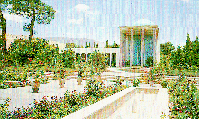
"Saadi's Tomb"
Hafez lived in
Shiraz from 1300 to 1389. His verses are well-known to all Iranians and, six
centuries later, have still value as aphorisms. His extraordinary popularity is
due to his simple, and frequently discursive language, rid of any affection and
to the use he makes of familiar images and of proverbial expressions. Iranians
feel that his best poetry is the "Ghazal" engraved on his tomb. The
Ghazal is a six to fifteen verse composition in which the verses are linked
together by a unity of inspiration and of symbolism rather than by a logical
sequence of ideas. Here are a few verses:
Sit near my tomb, and bring
wine and music - Feeling thy presence, I shall come out of my sepulchre - Rise,
softly moving creature, and let me contemplate thy beauty.
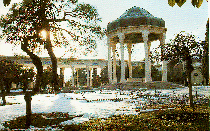
"Hafez-e Shirazi"
The populous
quarters in the center of the city are busy trading areas. The picturesque
quality of the Iranian bazzar is enhanced here by the presence of nomads or
semi-nomad elements belonging to southern Iranian tribes, including the Qashqais
recognizable by the women's brightly colored dresses. The open space of a large
esplande to the south of the bazzar gives one a chance to appreciate from a
sufficient distance the elegance or at least the originality of pear-shaped
domes above a high tambour covering two mosque mausoleums: The Shah Shiragh and
Seyed Mir Mohammad Imamzadehs. The facades of the two buildings are not shaped
like those of traditional ivans. It is a portico supported by light columns in
the style of houses in Shiraz.
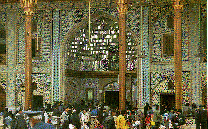
"Shah-e-Cheragh Mausoleum "
Near the
Bazaar-e Vakil, Masjed-e Vakil, the Regent's Mosque is especially famous for its
large prayer hall (75 meters long, 36 meters wide) covered with small cupolas
resting on forty-eight twisted columns cut out of one single block of stone.
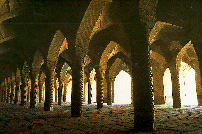
"Masjed-e Vakil"
Several other
religious edifices are worthy of interest. The Old Friday Mosque has in the
middle of its courtyard, a building found in no other sanctuary: The Khoda Khane
- "House of God" - a square building (which reportedly) imitates the
Kaaba in Mecca and where the mosque's Korans are kept.
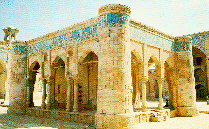
"Khoda Khane - House of God"

[home][IPM][Perspolis]











